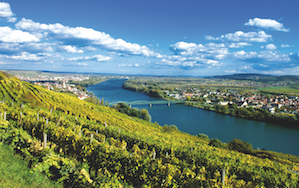.............................................................
Austrian wine has come a long way since the diethylene glycol scandal back in 1985. Austrian wine producers, understandably, hate references to it. But Willi Klinger, managing director of the Austrian Wine Marketing Board, in announcing record export figures for 2014, referred to it at a press conference at the recent Prowein exhibition. It bears resurrecting if nothing else than to show just how far Austrian wine has come since then.
So what was the diethylene glycol wine scandal? Firstly, it is important to stress that no one died, no one was hurt – unlike similar adulterations involving the likes of olive oil.
Basically a number of Austrian wineries adulterated their wines using diethylene glycol, an ingredient in some brands of antifreeze, to make them sweeter and more full-bodied in the style of late harvest wines. Many of these wines were exported to Germany, some of them in bulk to be bottled at large-scale German bottling facilities.
At these facilities, some Austrian wines were illegally blended into German wines by the importers, resulting in diethylene glycol ending up in some bulk-bottled German wines as well.
The scandal made headlines around the world. The affected wines were withdrawn and a number of people involved were sentenced to prison or heavy fines in Austria and Germany.
The short-term effect of the scandal was a complete collapse of Austrian wine exports and a total loss of reputation of the Austrian wine industry.
It has taken the country a long time to recover but the long-term effect has been that the industry has focused on other wine types – primarily dry white wines instead of sweet wines – and increasingly targeted a higher market segment.
In announcing export sales of €146m for 2014 – the ninth consecutive increase – Klinger made a point of stressing that not only was there a 6% increase in quantity but also a 5% increase in value. The average price per litre has gone from €0.83 in 2003 to €2.93 last year. Thus, significantly, Austria continues to move away from cheap, jug (bulk) wine, particularly to its main export market, Germany.
Germany remains Austria’s principal export market with a 55% value share (+5% volume and nearly +3% value). Switzerland is second: volume +8% and a high price per litre of €6. The US saw volume up 18% and value up 15%. The board also reports export growth in the Netherlands, Belgium, Scandinavia, UK and China.
Klinger says: “In all these countries, we have made it through consistent efforts to build efficient distribution. These counties shall continue to grow, adding to the main export markets and will certainly play an increasingly important role in the future. This will bring us closer to our goal of an export value of more than Ä180m.
Austria has also seen growth in Italy, Slovakia, Poland, Croatia, Bulgaria, Romania and the Baltic countries, Canada, Australia and Japan.




